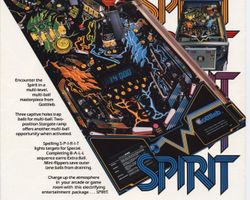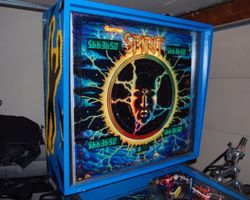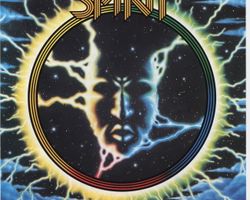Spirit

Average Prices: Not enough auctions
Produced: November, 1982
Production Run: 1,230 units
Machine Type: Solid State Electronic
MPU: Gottlieb System 80A
Players: 4
Design by: John Trudeau
Art by: Terry Doerzaph
"Spirit" pinball, released by D. Gottlieb & Company in October 1982, represents a distinctive moment in pinball history. Emerging from the System 80A era, this widebody machine is celebrated for its complex playfield, captivating artwork, and innovative features. Designed to enthrall players with its otherworldly theme and challenging gameplay, "Spirit" remains a sought-after title for collectors and enthusiasts alike.
History and Background
Manufactured by Gottlieb, "Spirit" materialized during a period where pinball manufacturers were experimenting with both gameplay and cabinet design. The machine’s thematic elements lean into science fiction and the supernatural, inviting players into a cosmic realm filled with mystery and intrigue. John Trudeau is credited with the design of "Spirit", while the visually striking artwork is attributed to Terry Doerzaph. Their collaboration resulted in a machine that is both mechanically intriguing and aesthetically arresting.
Production of "Spirit" commenced in October 1982, with the bulk of the manufacturing finalized by November of the same year. Limited to a production run of just 1,230 units, "Spirit" was Gottlieb's third and final foray into multi-level widebody designs within the System 80 series. This limited production contributes to its desirability and value in the contemporary pinball market. An interesting feature of "Spirit" is its mechanical backbox animation, a rotating disc that simulates a starfield, adding a layer of visual depth to the game's presentation.
Signature Features and Design
"Spirit" distinguishes itself with several standout features that are integral to its gameplay and overall appeal. The machine boasts an impressive six flippers, a configuration rarely seen and which significantly impacts player strategy. A prominent element is the "Star Gate" ramp, a mechanism that elevates to reveal the multiball lock. This dynamic feature is central to progressing through the game and heightens the excitement of achieving multiball.
The widebody cabinet is itself a significant design choice, allowing for a more expansive playfield and the incorporation of multiple mini-flippers. These smaller flippers, positioned in the outlanes, offer players a chance to execute ball saves, adding a layer of skill-based recovery to the gameplay. Furthermore, "Spirit" features a bonus display positioned centrally on the playfield, under a blue tinted window. This unusual placement draws the player's eye down into the playfield area, enhancing engagement with the ongoing action. The backbox animation, with its rotating starfield, provides a kinetic visual element that complements the space theme and sets it apart from static backbox designs.
Playfield and Mechanics
The playfield of "Spirit" is a multi-leveled landscape rich with targets, ramps, and interactive elements. It features two ramps, a single pop bumper, and six slingshots, creating a dynamic and unpredictable playing area. Two banks of 3-drop targets and eight standup targets offer a variety of scoring opportunities and objectives. Four kick-out holes add further complexity to ball trajectory and control. A unique "roundabout" lane in the upper playfield introduces an additional element of shot variety.
The layout philosophy of "Spirit" appears to prioritize shot diversity and player exploration. The multi-level design encourages players to aim for different areas of the playfield, utilizing all six flippers to navigate the intricate network of ramps and targets. The artwork on the playfield, crafted by Terry Doerzaph, is consistent with the backglass and cabinet art, depicting a cosmic scene with vibrant colors and otherworldly figures. The lighting scheme is designed to accentuate key playfield features and create an immersive atmosphere, further enhancing the game’s supernatural theme.
Gameplay Dynamics
"Spirit" offers a gameplay experience defined by its multiball feature and strategic flipper usage. The primary objective revolves around activating multiball, which can be either a 2-ball or 3-ball mode, adding significantly to the scoring potential and excitement. Players must skillfully utilize the six flippers to control the ball across the wide playfield, aiming for ramps to access the Star Gate and lock balls for multiball. The outlane flippers are not merely decorative; they are integral to skillful play, offering opportunities to rescue balls that would otherwise be lost.
The game's scoring system is interwoven with hitting drop targets and standup targets, and progressing through sequences to maximize bonus multipliers. While specific game modes as such are not explicitly defined in the traditional sense of modern pinball machines, the core gameplay loop centers on building bonus, achieving multiball, and strategically utilizing the playfield's diverse shot opportunities. A memorable aspect of gameplay is the challenge of mastering the six flipper layout and using the outlane flippers effectively – a skill that distinguishes proficient players.
Reception and Legacy
Reception of "Spirit" within the pinball community is generally favorable, with enthusiasts appreciating its unique qualities. Praised aspects consistently include the exceptional artwork, particularly the backglass, and the immersive sound design that complements the game’s theme. The gameplay is often lauded for its depth, offering a multitude of shots and strategic options thanks to the six-flipper configuration. Many players find "Spirit" to be highly replayable, drawn back by its challenging yet engaging gameplay.
However, some criticisms have been noted. A common point of feedback is that "Spirit" can play at a slower pace compared to some other machines of its era, with longer ball times. This can be perceived as less exciting by players who prefer faster, more frenetic gameplay. Additionally, the complexity of the playfield and ruleset can present a learning curve for new players. While the widebody design and six flippers are seen as strengths by many, some players find the layout less cohesive in terms of flow compared to narrower body machines.
Despite these points, "Spirit" has solidified its legacy as a distinctive and valued machine from Gottlieb's System 80A era. Its limited production numbers and unique features contribute to its desirability among collectors. "Spirit" stands as a testament to Gottlieb's willingness to experiment with design and gameplay, offering a pinball experience that remains captivating and unique within the broader history of pinball.
 Active Auctions
Active Auctions
 Auction Results
Auction Results
| Cost | Location | Date |
|---|---|---|
| USD $16,200 |  Ohio, United States Ohio, United States |
22 February, 2024 |
| GBP £1,220 |  United Kingdom United Kingdom |
29 November, 2020 |
| EUR €990 |  Saarland, Germany Saarland, Germany |
02 November, 2016 |
| USD $5,833 |  Colorado, United States Colorado, United States |
03 May, 2016 |
| USD $6,995 |  Canada Canada |
30 September, 2014 |
| EUR €1,065 |  Baden-Württemberg, Germany Baden-Württemberg, Germany |
24 March, 2011 |
| AUD $1,906 |  Victoria, Australia Victoria, Australia |
28 November, 2010 |
| EUR €741 |  Niedersachsen, Germany Niedersachsen, Germany |
16 September, 2010 |
| USD $510 |  Illinois, United States Illinois, United States |
02 April, 2009 |
| USD $250 |  United States United States |
01 April, 2000 |


Private Policy · Search Website · Contact Us
All trademarks and copyrighted materials remain property of their respective owners.
All other content copyright 2007 - 2025 Pinpedia.



